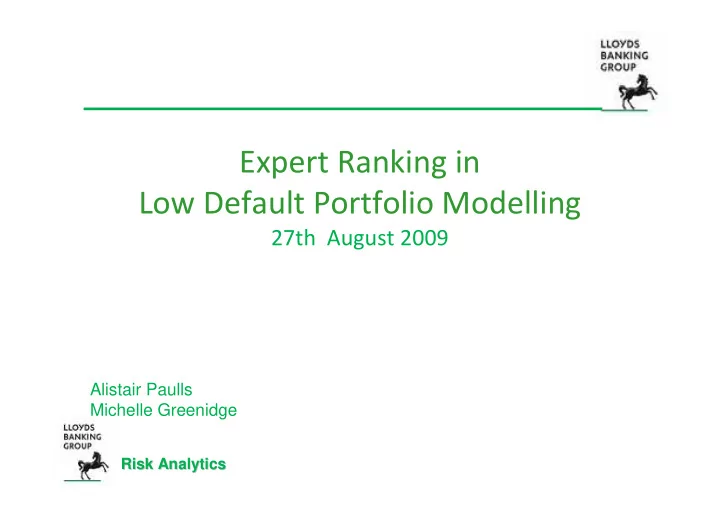

Expert Ranking in Low Default Portfolio Modelling 27th August 2009 Alistair Paulls Michelle Greenidge Risk Analytics Risk Analytics
Overview • Introduction – What is an expert rank order? – Why do we need to perform it? • Data Sources & Availability • Process Overview & Practical Challenges • Weakness and Bias in the Process • Effectiveness of Expert Ranking for Building PD Models • Validation and Model Monitoring • Conclusion Risk Analytics Risk Analytics
Expert Ranking • What is it? – Experts rank order a number of obligors based on defined criteria. • Why do we need to perform one? – Lack of hard data from both internal and external sources • Applications of the expert rank process include:- – Generating the target variable for a PD model build – Validation of a candidate model – Annual validation of an existing model Risk Analytics Risk Analytics
DATA SOURCES & AVAILABILITY • The main need for performing an expert rank ordering process is to supplement a lack of hard data: – INTERNAL DATA • Primary data source which should, carry the greatest weight in decisions throughout the modelling process but it may be inadequate because: • Insufficient time series, Insufficient data points, Missing data • Fundamental change in past, present or future business practice – EXPERT JUDGEMENT – EXTERNAL DATA Risk Analytics Risk Analytics
Process Overview & Practical Challenges • Data Availability – Sufficient Information • Determining the Experts – Extensive Experience • Consistent Method • Number of Risk Buckets • Reducing Bias / Subjectivity – Independence of experts Risk Analytics Risk Analytics
Process Overview & Practical Challenges • Number of Risk Buckets – Do not force into uniform distribution! – Ability to differentiate between deals – Minimum 20 deals for every bucket Risk Analytics Risk Analytics
“Split” Method Risk Analytics Risk Analytics
Weakness and Bias • Hindsight Risk – Some suggest that we use deals for which we have at least a full year’s data – Knowledge of default post sample collection date may influence opinion – do we include the bads? – What if they don’t rate the true bads as worst do we abandon? – Do you only use recently sanctioned deals – the data necessary will be available? • Scorecard in your head – Modellers should not influence the experts by suggesting risk drivers - this is often done inadvertently Risk Analytics Risk Analytics
Weakness and Bias • Information imbalance – Additional information from knowing the deal personally – Some historic data more complete than others – More specifically - what information should we provide? • Make the deals anonymous - perhaps ideal – Problems – niche portfolios the experts will recognise them with or without a name; resource • Provide full credit application information – allows for full and robust assessment but may mean that some deals have more information than others (depends on who prepared the credit application!) Risk Analytics Risk Analytics
Weakness and Bias • Appropriate use of risk buckets – Reluctance to assign to poorest bucket – Instruction needs to be robust in addressing the fact that this is about default not loss • Some instructions and their consequences: – Instruct that there is a reasonable spread across the risk distribution, makes it easier to get a model that differentiates well but …….. Is limited for validation purposes – Even number in risk grades / ranks - real possibility of spurious differentiation – Allocation to buckets representative of risk distribution - possibility of one big lump Inappropriate rank distribution • – Portfolios spanning different business areas or geographical regions – Modelling and diplomatic impact! Risk Analytics Risk Analytics
Expert Ranks - 6 Bucket Exercise (N=131) �� �� ������ ������ ������ ��������������� �� �� � � �� �� �� �� �� �� �������������������� Risk Analytics Risk Analytics
Weakness and Bias • Resources – Appropriate experts – are there any? – Who:Credit Sanctioners & Business colleagues – Experts time / willingness • Fatigues – Can be very time consuming and repetitive – Could lead to complacency – the “I know this one syndrome”! • EGOs training in psychology would be useful Risk Analytics Risk Analytics
Validation & Model Monitoring • Not enough internal default data • Expert ranks used to validate model discriminatory power – Direction of PD estimates – Discrimination of average PD by rank….. • Soft definition of default Risk Analytics Risk Analytics
What do I do? • Ask the question – Is there another way? - ask this seriously and of more than one person. Hope and pray if you have religion ( and even if you don’t) that the answer is ‘YES’ • If it is NO – Plan plan plan – Recruit your experts well and with consultation – Make your instructions clear – Record everything – Show pictures of the results to colleagues in the know is the shape what they would have expected? – if not why? Risk Analytics Risk Analytics
Conclusion • Expert ranking should never be a first choice! • Your experimental design should be context dependent • Results can only be evaluated in light of process choices • Useful for niche portfolios or those with little default experience and no external ratings • Validity of process should not be underestimated • Provides an in house view of what constitutes our risk • The hard slog involved in doing this properly cannot be avoided Thank You! Risk Analytics Risk Analytics
Recommend
More recommend